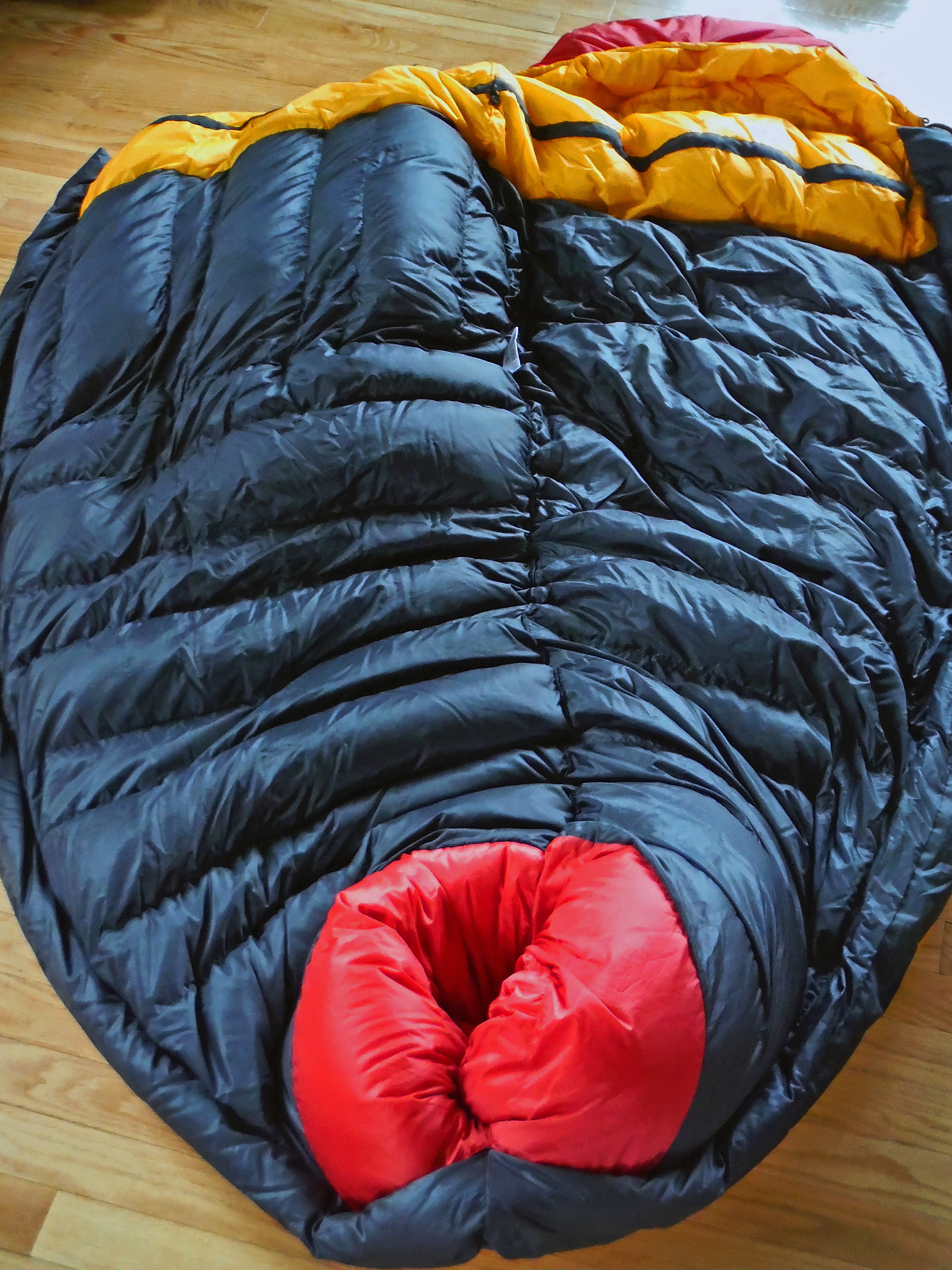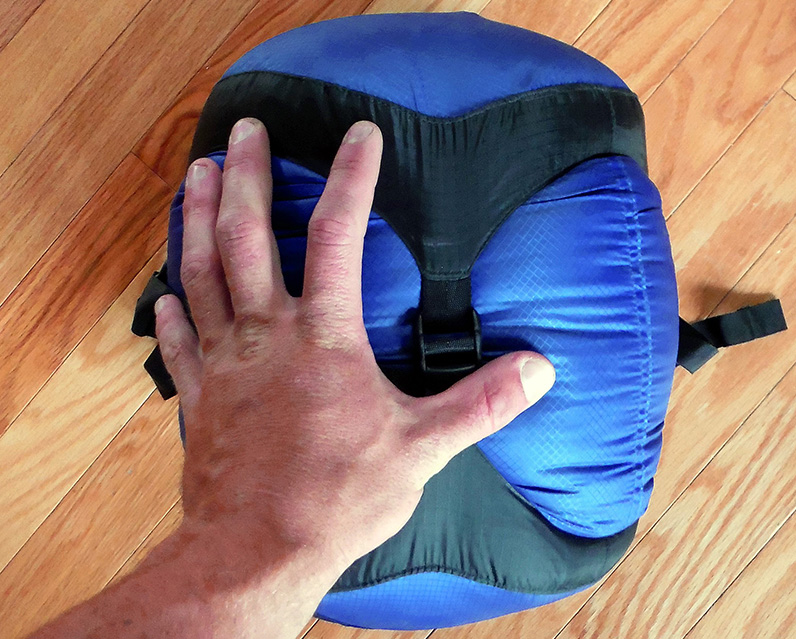Performance
Fast forward to December when I got my Hispar 800. Night one was forecasted to be 8F, and I anticipated a nice warm night for a change as I zipped up the sleeping bag.
Three hours later, I frantically unzipped and threw open the bag. I was shocked to wake up to sweat pooling on my chest, and was much warmer than I had anticipated. This became par for the course—the Hispar 800 is far warmer than I had expected.
Then I began to see when, or where, the bag would fail me.
I began to unzip the bag half way when temps were in the single digits, and even with a cold breeze rolling through, I would sleep comfortably through the night.
I went out on multi-day ski trips, and slept under the stars while it was in the negative single digits with 20 mph gusts of wind. I would undo the draft collar and open the zipper in the footbox after my initial warm-up period, then sleeping comfortably through the night.
Later in the winter I slept directly on the snow while it was -10F. In the middle of the night my shoulder got cold because I had packed out the down under it. So I rolled over and distributed my weight more evenly over the bag, then proceeded to sleep comfortably through the rest of the night without complaint.
And even after my body heat melted out a few inches of snow under the bag, the H2X material did not allow any water through, protecting the down fill.
The construction of the bag appeared on point for what I would expect from a sleeping bag in this price range, and the performance of the Hispar 800 greatly exceeded my expectations. It was fully waterproof when sleeping in the snow, and remained extremely warm. I had almost no down leakage, except for a little that was caught in the stitching during production. And the H2X waterproof material in the hood resisted dirt and grime better than any other inner material that I’ve experienced.
The vertical baffles in the chest allowed for significantly greater loft and warmth than other designs. It felt like an electric blanket, as it provided a zone for down to loft without shifting laterally over time.
I did not have any issues with down travel in the lower portions of the Hispar 800, and actually, throughout the season, I had no noticeable movement of the down fill anywhere in the bag—a problem I have encountered with other sleeping bags.
I have still not noticed any degradation in the down, either. Even after complete compression, the down re-lofts with a quick shake within a minute or two of being pulled out of the compression sack.

Since I am a fairly active sleeper, I found the fit to be a little snug in the lower half of the bag. This was also a bit limiting when getting dressed while in the bag in the morning. I suspect a slightly wider bag would have easily solved this minor annoyance (though possibly at the expense of some of the bag’s warmth).
The length of the standard bag fit my 5’10” frame like a glove; my feet and head were at the ends of the sleeping bag without applying pressure, even with ski boot liners on.
Between the width and length of the bag, there was no dead space within the bag—no extra / unnecessary space to heat—and yet the bag wasn’t too restrictive or so tight that it compressed the down fill.
During the winter I did not sleep at the -27F that this sleeping bag is rated to. I was however, within 12 degrees of the minimum recommended limit, and wouldn’t hesitate to use the Hispar 800 in temps to—or beyond—its rating limit. As previously mentioned, I was extremely warm every night I spent in the sleeping bag, and I never had it fully zipped or with the draft collar sealed even at -15F. Another 12 degrees and I might have had to zip up the footbox (the double zip was crucial for regulating my personal temperature on warmer nights).
Friends of mine occasionally borrowed the Hispar, including some who are notoriously cold at night. They slept well through nights that fell well below freezing, and were not happy to have to return the sleeping bag to me.
In short, sleeping in an unheated vehicle through the winter in Aspen, Colorado was easy and comfortable in the Hispar 800.
Packability
On the ski tours and desert trips that the Hispar 800 accompanied me on, the packed size was crucial when carrying 2-4 days worth of supplies. The weight and size of the Hispar 800 is incredible given the warmth it provides.

In a lightweight, waterproof compression sack fully cinched down, the packed dimensions were 12”x9”x8”, slightly smaller than the 17”x10” description provided by PHD. And when combined with the stuff sack, the weight of 3lbs 8oz made for quite an easy load to bear.
Features
The Hispar 800 sleeping bag includes: YKK double zippers; double draft tubes lining the zipper to cut wind coming through the zips; a full draft collar; and a mummy style hood.
The zipper is as smooth today as it was the day it arrived, no surprise for the industry standard YKK zipper. As mentioned previously, it is a double zip which allowed for me to open up the bottom of the bag, which is a must for me.
I did find that the zipper did bind up with the inner fabric of the bag, which is protected by a stiffer tape or material to head off snags and tears caused by the zipper, this served to be a minor annoyance, but the zipper never got stuck and no damage to date has been done as a result of these snags.
When I was out in colder, windier conditions the hood cinch and draft collar made a massive and immediately noticeable difference in cutting all drafts. In other bags with draft collars I have found them to be uncomfortable as they applied pressure on my throat/neck, whereas the Hispar came down closer to my collar bones and didn’t leave me feeling choked.
The Hispar 800 lacks a stash/security pocket, a feature that I would have liked, though this is hardly a deal breaker.
The Hispar 800 comes with a mesh storage sack as well as a normal nylon stuff sack. I found the stuff sack that accompanied the sleeping bag was insufficient when compressing the bag down fully, so opted for a lightweight, waterproof 14L compression sack.
Bottom Line
I spent over 90 nights in the PHD Hispar 800, and not a single one involved a shiver while sleeping. I slept in my unheated van at trailheads in the San Juans before ice climbing and ski trips; in tents in the mid-winter desert; under a blanket of stars on multi-day ski tours; and everywhere in between.
The Hispar 800’s 950 fill down had an unbelievably high weight-to-warmth ratio, as one would expect. Couple that with an almost perfect fit and a waterproof outer, and this bag proved to be perfect for this past winter and for future cold weather expeditions.
My only (admittedly nitpicky) gripes are: the lack of a stash pocket, occasional zipper snags, and a slightly snug fit.
Still, I highly recommend this bag to anyone looking for a lightweight, compressible, very warm winter bag that looks like it will last for many seasons to come.

Did you have no problems with moisture? Sounds like you sweat a bit in the bag and had some wet nights on snow. Did you have to take some time to dry the bag out on your multi day ski tours?
Thanks for the review, makes m want to do some multi day tours in the near future!
No issues with moisture and the down wetting out. I would typically pack my sleeping bag last in the morning and set it out first thing when arriving after skinning but beyond the drying that occurred during that time, there wasn’t anything specific that I did.